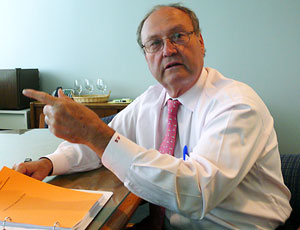After more than 30 years of national and international consulting, Bob Sternhell, principal of Solutient Inc., New Orleans, is well versed in the intricacies of working with government agencies. His services include handling all the documents and transactions needed to capture federal risk mitigation grants after disasters so local governments, construction crews and homeowners can get to work.


“No single contractor or local government would have the ability to plow through all the paper work and all the negotiations,” Sternhell claims. He says it is a slow and cumbersome process that few localities are prepared for. “If there were a hurricane today, it would be six months before the government had any estimates of funds available, and then it would take two years to get the funds to people,” he says. “That’s just a fact of life in working with government. It all takes a long, long time.”
But Solutient, and its partner, Walton Mitigation Services, New Orleans, has pulled together a total $182 million in risk mitigation grants in Louisiana out of the total $1.4 billion available.
In turning the grant opportunity into elevated homes, Sternhell says construction constitutes about 40% of the work. The rest requires knowing how to expedite the paperwork and politics between all of the concerned parties, from the Federal Emergency Management Agency on down. “Imagine us as a clearinghouse among the following actors—FEMA , FEMA regional, the local FEMA temporary office, the state, the client, who is almost always the parish or the city, the homeowner, the contractor—who actually does the elevations—and a number of other public agencies from which we gather information,” Sternhell says.
“When [hurricanes] Katrina and Rita struck, the magnitude of damage was unprecedented. Local governments are not prepared because this sort of hazard mitigation requires an expertise that is only required every few years.”
In Louisiana’s Jefferson Parish, Solutient and WMS are providing that missing expertise, says Warren Davie, owner of Davie Shoring, Inc., Kenner, La. Before those companies joined forces earlier this year to organize the work, Davie says he handled three or four hazard mitigation projects a year. But now Davie has elevated about 64 homes under the program in 2008. “They have really facilitated these programs,” Davie says. “Other parishes have tried it on their own instead of having a program management company, but they couldn’t handle the volume of paperwork and everything it took to truly manage a project.”
Davie says Bill Petty, president of Walton Mitigation Services, is committed to the program because “he knows how it helps the citizens,” Davie says. “For years I had people tell me, why don’t all these big companies get involved and make it happen? It wasn’t worth it for them, but Bill has gone out of his way to do the right thing.”
Darren Williams, program manager for WMS, says that the risk mitigation enterprise is not the biggest moneymaker for WMS, but he says it makes sense in a couple of ways. It is “about making life better, and ultimately improving the community,” and, Williams says, it also gives Walton a line of business that doesn’t carry the same risks or bond requirements as the role of general contractor. “In a construction project, you assume all the risk, even though as a general you may only perform 10 to15% of the total work,” Williams says. “In program management, your risk is only on the performance of program management, and the monetary risk rests on the client or sub-client. We are always looking for ways to expand our resources without having to obligate ourselves with greater capacity.”
How Solutient Works
Once a disaster occurs, “before you can say any 500 million words in the English language, funds come down from Washington,” Sternhell jokes, emphasizing how long the first step of the process can take. Once grant applications are made, it may be three to six months before the applications are accepted. The time from acceptance to construction completion may take two to three years, Sternhell says.
To track all the parts and pieces, Solutient developed its own software, called M3. Sternhell calls it “by far the best and maybe only software application to track the transactions involved in hazard mitigation.” The software tracks every contact by e-mail, telephone or document, between all the parties. It can generate a report in minutes to answer any question a parish, state or federal official may have. “The joy of it is that because we track every financial transaction, the chances of misuse of money is so reduced that they have greater faith,” Sternhell says. “We can guarantee no misappropriation of funds.”
That has already proved to be a selling point to both FEMA and Louisiana State auditing officials, he says. Although the application would likely work in other industries, Solutient is not looking to sell it at the moment because of its enormous value in the current projects. However, Sternhell’s goal is to eventually use lessons learned in the technology and program management to penetrate other hazard mitigation markets throughout the country. “We are talking to folks in Texas, but are not currently engaged in any contracts there yet,” Sternhell says. “Think about it. Katrina was three years ago, but we’ve only been given funded grants one year ago.”
With the current HMPG grant application deadline scheduled for September 2009 and much of the money still untapped, the joint venture partners are concentrating on hazard mitigation in Louisiana. “We could go at a pace five times faster than we are,” Petty says. “There are plenty resources out there — money, equipment, manpower and materials—to elevate 100 homes a month.”

Post a comment to this article
Report Abusive Comment